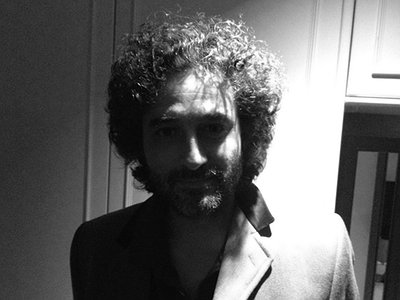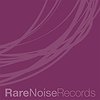Name: Giacomo Bruzzo
Nationality: Italian
Occupation: Label Founder of RareNoise Records
Recommendations: Philipp Gerschlauer, David Fiuczynski, Jack DeJohnette, Matt Garrison, Giorgi Mikadze – Mikrojazz (Neue Expressionistische Musik) (RNR083 / RNR083LP)
Karl Popper - The Open Society And Its Enemies Vols I&II – Routledge
Website / Contact: If you enjoyed this interview with Giacomo Bruzzo, visit the website of RareNoise Records for new release updates, current tour dates, background information and music.
When did you start with your own label - and what or who were your early passions and influences? What is about music and/or sound that drew you to it?
Hello there, thank you first and foremost for giving me the opportunity to share thoughts about the label and the spirit that animates it at the core.
RareNoise was formally born mid 2008, its first release though dates May 2009. Founded by myself and Italian sound sculptor and producer Eraldo Bernocchi, it was the unexpected outcome of a protracted period of personal search and struggle;
My formal education over the decade and a half since the early nineties had been rooted in philosophy, economics, statistics and eventually pure mathematics, my (unfulfilling) working life tied to the financial services sector during the same arc of time: the (traumatic) realisation of the inadequacy of all of this lead me on a quest to reconnect myself with the truthful drivers and aspirations of my existence, my ancient passion for music being at the core of it all.
I eventually approached Eraldo Bernocchi, whose ‘Charged’ (with Bill Laswell and Toshinori Kondo) I had been long been a fan of, with a view to interviewing him for a three part documentary I had started to write. This documentary was projected to narrate the music histories of three musicians I was particularly fascinated by at that time, Eraldo, Laswell and Yoshihide Otomo.
To my great surprise, Eraldo consented to us meeting and to an extended interview; our conversations, which started early in 2007 spiralled quite literally out of control. I initially assisted Eraldo and his wife, visual sculptor Petulia Mattioli, in organising two audio-visual events (Liquid Light in Genoa with Nils-Petter Molvaer and Black Engine with Zu in Rome); We soon realised, though, that we needed to expand our collaboration into a platform to support this curatorial vision, which lead to the birth of RareNoise.
RareNoise is not tied to genre or any form of categorisation and/or classification – as such it is a ‘free’ label, if you will allow me to abuse the term. RareNoise’s mission statement (which kind of imperfectly crystallised from an initial ‘tatônnement’ period) is
‘to detect and amplify contemporary trends in progressive music, by highlighting their relation to the history of the art-form, while choosing not to be bound by pre-conceptions of genre. It seeks to become a guiding light for all those enamoured by exciting, adventurous and progressive sounds.’
This approach resulted a body of releases that span a pretty wide manifold of genres (as understood by critics), often within a single production, the only thin red line being, that we seek to share a moving, heart-rending, listening experience with the audience: electronica, minimal or not, electroacoustic music, dub, jazz, traditional jazz, electric jazz, free jazz, free rock, noise rock, noise and power electronics, abstract heavy metal, mutated grindcore and the infinite convolutions between all of these rivers of musical nous – it really does not matter. What does is a sense of surprise, a sense of vertigo, a sense of simultaneous bewilderment and familiarity we would like the audience to embrace, thus affording them a intimately personal, fleeting yet immobile glimpse of the deep fluttering of the arbitrarily distant and large (that is RareNoise).
For most artists, originality is first preceded by a phase of learning and, often, emulating others. What was this like for you? How would you describe your own development as a label curator and the transition towards your own approach? What is the relationship between copying, learning and your own creativity?
I think this is a very natural and fruitful framework to analyse the process of evolution I underwent over the last eight years.
At the outset there is a pure drive to create, a very rough one possibly, one informed by a sense of unease with where one is at that given moment and by the desire to redress this state of things.
One starts by looking back to the whole memorial of listening experiences and the aesthetics associated with them - In my case an uneven mental library of musics dating back to the eleventh century, from early Carmina Burana across the Middle Ages, to Renaissance, Baroque, Classical, Modern, Classical, through Ragtime, Blues, then Jazz and Rock in all their variations, Electronica popular and august, Concrete Music, through to the myriad ever-spreading, ever-criss-crossing multiplying rivers of cross-pollinating sounds that have come to characterise music in the last thirty years.
One then tries to remember what were the first recordings one ever bought, and what world of feelings they opened up – in my case I remember coming home one day with my first three records ever, a copy of Paul Simon’s Graceland, of Mahavishnu Orchestra’s Between Nothingness and Eternity and of Beethoven’s Fifth Piano Concerto, with Rudolf Serkin on piano and Seiji Ozawa directing the Cleveland Orchestra on Telarc. I remember feeling one and only vibration whilst listening to all three, a sense of fearlessness on the cusp of falling without end and how it gave me meaning.
Then one starts asking if there were ambassadors for such vision, in my case a plethora of both curated labels in classical music and a myriad other genres, the extreme and most obscure ones being the ones most germane, and crucial musicians acting as a nexus, Bill Laswell being the most obvious in recent times. This lead me to study the strategies of labels such as Celluloid, Axiom, Atlantic, ECM, RealWorld, Archiv Produktion of DG (to cite but a few), certainly seeking for inspiration.
The beginnings are then obviously informed by what material is available at that time; equally, if not more important, are the dynamics one tries to apply to these initial conditions – leading ideally to a self-sustaining eco-system of artists who are happy to work with the label, because they see it as carrying values and a vision germane to theirs, as well as offering repeated opportunities to engage in creative endeavour and personal development.
As this organism starts getting into motion, I think it is both valuable and ultimately essential, to allow it to take form with only limited interference, to allow its emergent properties to come to the surface. This is precisely why I said before that RareNoise’s mission statement had ‘crystallised’ from a process of trial and error – it emerged: Essential is therefore, that one both be guided by one’s vision, but that one also be always ready to be guided by that of others, the choice of proportions and the ability to listen at crucial times ultimately determining the longevity of the enterprise.
What were your main label-related challenges in the beginning and how have they changed over time?
Challenges (and Opportunities) were initially attributable to the status of the world and industry at the time. RareNoise was born at a time when the financial crisis had brought the world to stillstand. Several physical distributors went bust at that time, the remaining ones were certainly unwilling to take on new customers, specifically untested ones – in the world of labels, longevity is a sign of credibility. This lead us to study all CMS + E-commerce platforms available at the time to set up an independent store to start with (we ended up developing a store based on Joomla and Virtuemart), a process, which was both maddening, but also incredibly enabling. Several lessons relating to the consumer side of the business were learned at the time – the importance of punctuality in shipment, of immediate 24/7 service and contact, and the importance of creating a community, but to do it cumulatively over time.
The challenges today are mostly due to the increase in the numbers of both releasable artists projects as well as distributor (b2b) and customer (b2c) base: the amount of work grows rapidly, and it has to be managed to avoid any compromise in quality.
How do you see the role of labels in the creative process? What is the scope and what are the limitations of what you are capable of doing?
In keeping with what has been said until now, I will start by saying, that I believe the role of a label should be that of creating an environment that artists aspire to participate in, as this will generally mean they will act as ambassadors to other artists in their communities. This usually entails, that we try to develop protracted collaborations with artists, encouraging them to meet and collaborate with each other, enabling them to pretty much realise their suggested visions. It also means that we try to be available in suggesting options (production, artwork or otherwise) if requested, but are also ready to embrace their ideas wholly. While imperfect, this mechanism is founded on the assumption, that artists wishing to work with us will be aware of our output, and will thus naturally ‘self-select’ themselves, thus greatly reducing the potential for misunderstanding or unsuccessful projects.
Whom do you feel your obligation to – the artists, the buyers, your own demands in terms of quality?
This again, is a deep question. The landscape we observe today is one resulting from a more than decade-long process whereby technical and financial barriers to the production of music have been lowered vigorously, to the point of near negligibility. This has resulted in an incredible supply of immensely creative often mind-blowing, genre-busting music saturating all niches (while truly pop music has become rather stale). This has gone hand in hand with the (essentially free, but self-serving) development of social media and trade-enabling platforms.
This has created fundamental conundrums:
- Artists have easy and cheap to access the ‘marketplace’, but have to contend with a multitude of ‘competitors’. They also have to divert excessive amounts of their time to activities that are complementary to the act of creation.
- Customers have access to ever-expanding libraries of essentially self or automatically curated music, often skimming but the top of what is available to them.
In this context, one, I must add, in which very virtuous circles of direct artist to listener relationships have emerged, I believe there is ample space and need for further parallel curator entities facilitating/mediating and guiding this relationship. They take many forms, be it cultural magazines, forums, trans-cultural publications, but also labels, in particular those dedicated to serving not so much a genre or a single community, but to creating bridges between music genres and associated communities, by encouraging cross-pollination between artists and artists, between artists and listeners and even listeners and listeners across the perceived divides.
Quality is a state of mind of the curator – it is the amount of time one dedicates to all details, it’s to do with constantly reviewing one’s processes, in trying to listen as much as possible, yet trying to constantly surprise and stimulate both the creators and listeners, to continuously feed the dynamics of this relationship.



